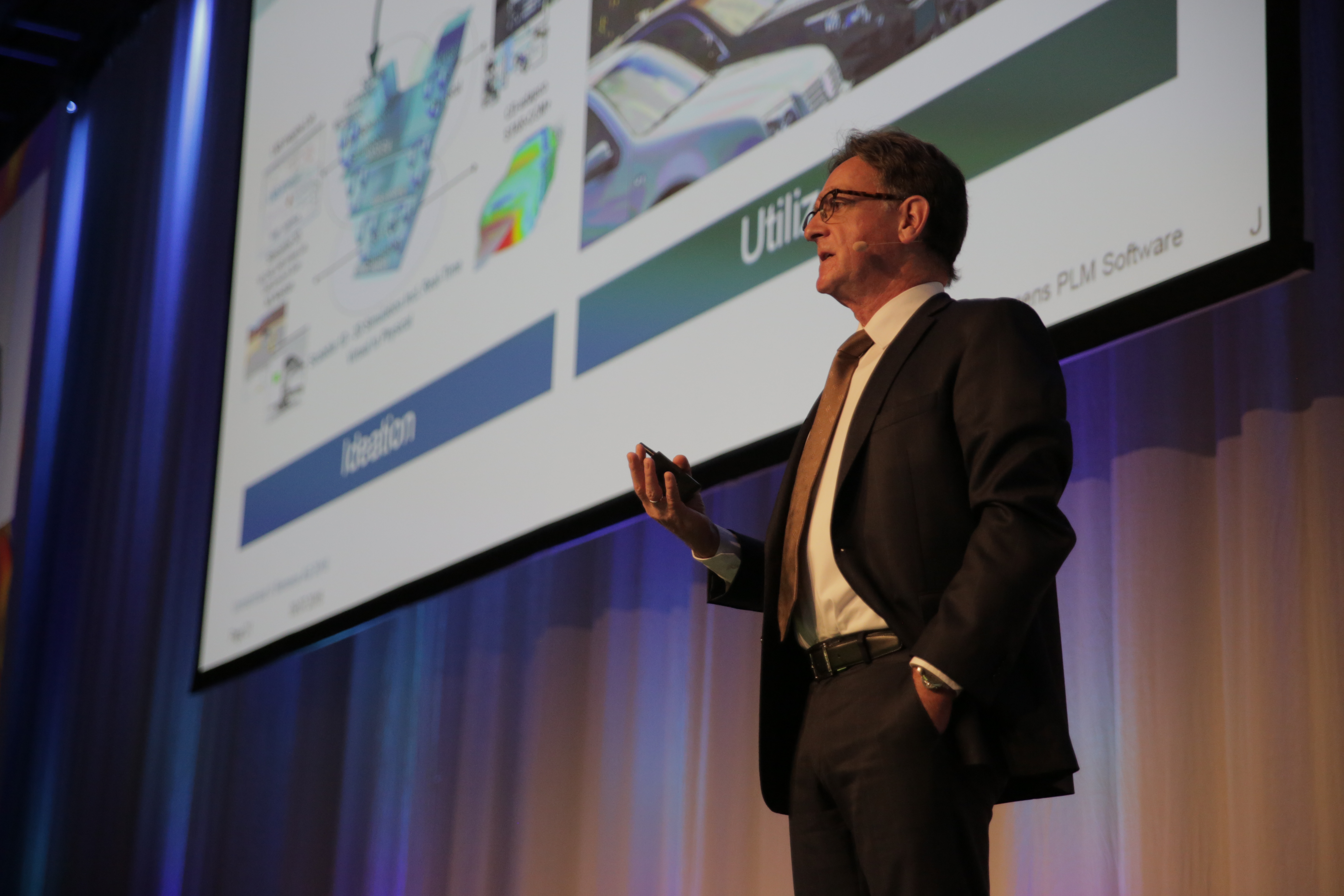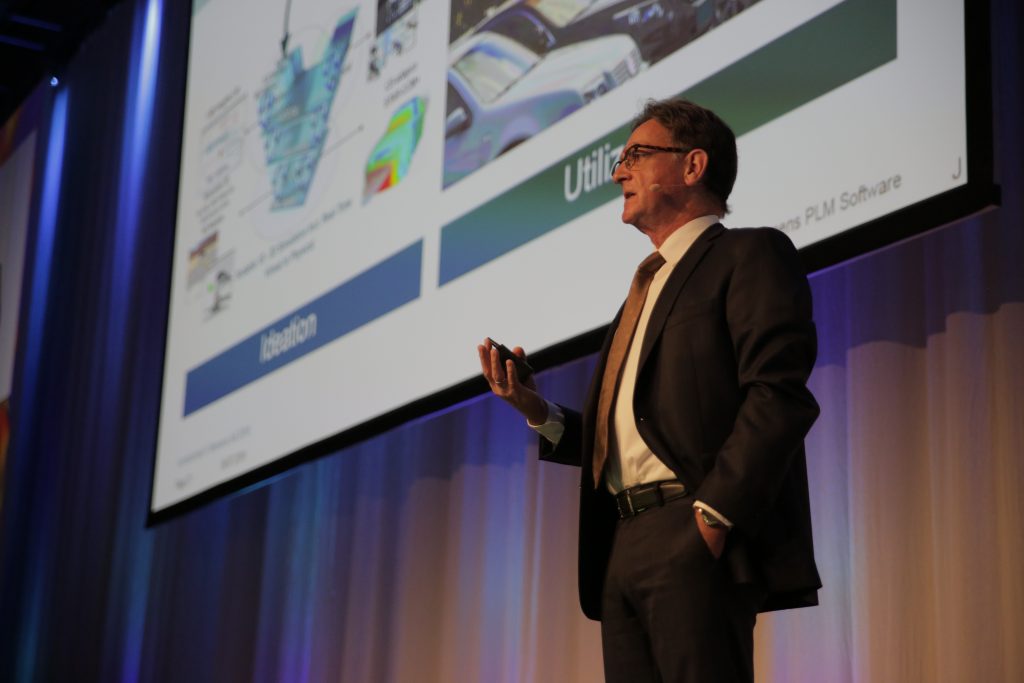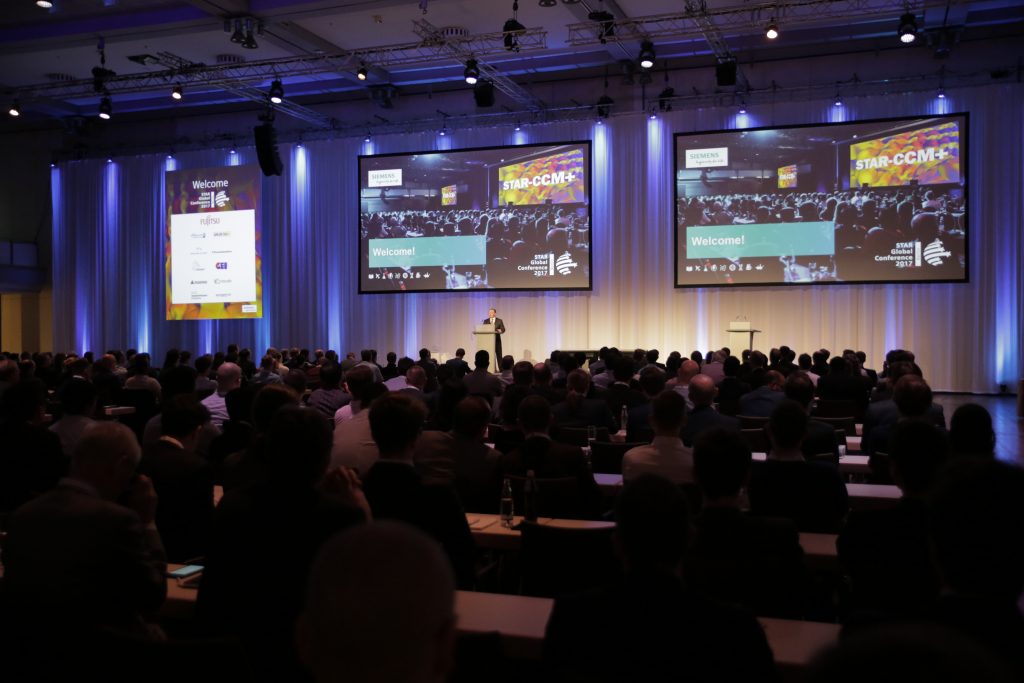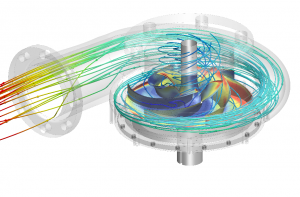
Dr. Jan Leuridan explains the Simcenter roadmap and the importance of the STAR-CCM+ portfolio in it. (Source: Siemens)
Latest News
March 20, 2017
When Siemens announced its acquisition of computational fluid dynamics (CFD) specialist CD-adapco in January 2016, existing customers had more questions than there were answers to match. Not long after, CD-adapco held its annual customer conference, but the deal had not yet closed; all CD-adapco executives could do was explain the rationale for the deal (see “CD-adapco STAR Global Conference 2016 Recap, Part 1”). In March 2017 the STAR Global conference convened in Berlin, and the answers users were wanting to hear were forthcoming.
 Dr. Jan Leuridan explains the Simcenter roadmap and the importance of the STAR-CCM+ portfolio in it. Image courtesy of Siemens PLM Software.
Dr. Jan Leuridan explains the Simcenter roadmap and the importance of the STAR-CCM+ portfolio in it. Image courtesy of Siemens PLM Software.The former CD-adapco product line in Siemens PLM Software will become part of the emerging Simcenter portfolio. As explained by Dr. Jan Leuridan, head of Simulation and Testing, Simcenter will do for simulation data what Siemens Teamcenter does for design and engineering data. “[Simcenter] will manage STAR data with complete lifecycle traceability, from project requirements to product design, to simulation, to results,” says Leuridan.
It should be no surprise that one of the billionaire companies in PLM (by annual revenue) would buy a company like CD-adapco. The lead product, STAR-CCM+ is used by 14 of the 15 largest automotive companies, by all top 10 suppliers in aerospace, and by nine of the 10 largest manufacturers in the energy and marine sectors. Siemens paid $970 million to add the CD-adapco line to the Siemens PLM portfolio, which also included the HEEDS line of multidisciplinary design exploration and optimization tools, from the acquisition of Red Cedar Technology in 2013.
 Attendees at this year’s STAR Global conference in Berlin met in Hotel Estrel, a hotel more like a Las Vegas conference center than a typical European business hotel. Image courtesy of Siemens PLM Software.
Attendees at this year’s STAR Global conference in Berlin met in Hotel Estrel, a hotel more like a Las Vegas conference center than a typical European business hotel. Image courtesy of Siemens PLM Software.Very few engineering teams rely on only one CAE software product. The ability of STAR-CCM+ to work equally well with all CAD software has been one of the keys to its success over the years. Leuridan says that openness will continue to be a STAR-CCM+ hallmark. Not only will STAR and HEEDS users be able to work with other CAD products, but they will also have version independence within the Siemens portfolio. In other words, any version of Simcenter will be compatible with any version of Teamcenter United. For Siemens NX CAD users, Simcenter will be accessible from the Rich Client and Active Workspaces user interface environments.
Simulation and Digitalization
Leuridan says the driver of business transformation today is digitalization, a word still being defined by industry. Gartner defines it as “the use of digital technologies to change a business model and provide new revenue and value-producing opportunities; it is the process of moving to a digital business.” Others extend the meaning to include digitizing systems and jobs as a process distinct from providing digital tools (such as CAD/CAE). It also refers to such concepts as Internet of Things (IoT) and Industry 4.0. Siemens told conference attendees there are four aspects of digitalization important to computer-aided engineering (CAE):
- Automotive transformation: 77% of automotive OEMs are working to become “pure mobility providers,” where the goal is not to deliver an automobile but to deliver transportation.
- Outcome economy: Products are being equipped with sensors and connectivity, creating the IoT ecosystem. In 2016 new Internet connections of sensors and other peripherals outpaced connection of new smartphones and PCs.
- Big data analytics: The processes of design and simulation are creating gigantic amounts of information that can only be relevant and useful if managed for present and future use.
- Connected world: There are 8 billion devices connected to the Internet today; by 2030 that number is predicted to be 1 trillion.
“Digitalization changes everything, everywhere,” notes Leuridan. “It is driving new business models and new operating models.” Siemens PLM Software says its role in the process is to help customers transform into digital enterprises, by focusing on three product issues:
- Changing the way products come to life, with new technologies such as generative design, predictive simulation and intelligent models;
- changing the way products are realized, with new technologies such as machine learning, additive manufacturing and robotics; and
- changing the way products evolve, through use of cloud technology, knowledge automation and big data analytics.
For CAE engineers in the meeting, Leuridan brought all this talk of business transformation and digitalization home. Mechanical components will become smart systems that integrate mechanical and electrical controls. Known materials and production methods will be transformed into new mixed materials and novel production methods. Defined product options will give way to mass customization and personalization. Internet connectivity will extend into systems of systems as it becomes the Internet of Things. Disconnected product models and supporting data will become a digital twin to the physical product. It is the last item especially that Siemens sees as an important role for the STAR/HEEDS line.
From Verification to Predictive Engineering Analytics
Siemens believes the historic CAE workflow model—design verification—is not going to cut it in the age of the digitization. Every aspect of digitalization in product development requires engineering simulation to move into predictive analytics. In a predictive environment, design is not so much created as it is discovered. This process requires new workflows and best practices that parallel modeling and analysis in search of the optimal solution. Test data, historical data, customer usage data and simulation data must all be accessible.
Predictive engineering analytics is the realm of what Siemens calls intelligent modeling for realized products. Multidiscipline, multi-physics analysis gains in importance as product design becomes more about systems development than creating a single product. “Now we unleash the full power of simulation by driving design requirements, using simulation to discover better designs faster,” says Jean-Claude Ercolanelli, senior vice president of product management. “The output is now many high performing designs,” instead of validation of one specific set of design choices.
Siemens realizes the new workflows must be supported by new ways of providing tools. Company representatives told STAR Global attendees that their delivery of software would become a more adaptive system, just as they see their users creating more adaptive systems. Cloud and desktop will both be used; there must be flexibility in license use; and the CD-adapco historic commitment to open standards must continue.
So far the new Simcenter portfolio consists of existing Siemens PLM Software long-time simulation products including Nastran NX; the product line acquired in 2012 as LMS; and the CD-adapco line. There was acknowledgment of the most recent Siemens acquisition, Mentor Graphics, but no explanation of how the various products from Mentor will be incorporated into Simcenter.
 The acquisition of CD-Adapco also brought the HEEDS line of design optimization software to Siemens. Siemens says one pump manufacturer who used HEEDS for design analysis achieved a 51% reduction in mass and a 31% improvement in throughput. Image courtesy of Siemens PLM Software.
The acquisition of CD-Adapco also brought the HEEDS line of design optimization software to Siemens. Siemens says one pump manufacturer who used HEEDS for design analysis achieved a 51% reduction in mass and a 31% improvement in throughput. Image courtesy of Siemens PLM Software.Cloud Simulation for the Small Firm
Like most software conferences, there was a vendor display area. Notable among the mix of implementers and add-on software tools was a new cloud-based service for running STAR-CCM+ simulations on demand. Trampo is the brainchild of Guillaume Jolly, a French engineer and STAR user now living in Australia. Jolly saw a market for smaller companies who want the power of STAR-CCM+ but cannot afford the licensing or hardware requirements.
Trampo uses a synchronized folder structure and a locked-in, IP-specific approach to cloud access for added security. When a user wants to run a simulation job, it is copied to the synchronized folder. Overnight the job is processed and the results made available. “In CFD, files are huge,” says Jolly. “One big issue with cloud computing is the waste of time experienced by the user when uploading and downloading the job.”
Unlike most cloud simulations, which are a blind run until completed, Trampo sends scenes in real time. “Scenes” is the STAR-CCM+ term for graphical CFD post-processing outputs. Trampo sends scenes in specified intervals. “It means the engineer can judge the convergence of the solution while running in the cloud and stop the compute job if need be,” says Jolly.
The cost of using Trampo includes the license fee. Jolly sees the target market as smaller companies that do not have a cloud license for STAR-CCM+ and require cloud simulation runs for 200 hours a year or less. The service starts with access to 24 cores for four hours for $199.
Subscribe to our FREE magazine, FREE email newsletters or both!
Latest News
About the Author
Randall S. Newton is principal analyst at Consilia Vektor, covering engineering technology. He has been part of the computer graphics industry in a variety of roles since 1985.
Follow DE





